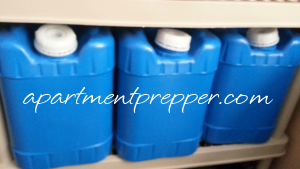This post is by Bernie Carr, apartmentprepper.com
Water is such a crucial need – you can only go three days without water. A lot of people who prepare plan to fill the bathtub before a hurricane, ice storm or other predicted emergency. However, if a disaster were to happen suddenly, it would not be possible to fill the bathtub ahead of time.
To be sure you are prepared for a sudden water emergency, store enough water for drinking as well as cooking, washing and first aid. I know it does sound like a lot of water, but the alternative is not having water when you need it. Start with at least one gallon per person per day, and have enough for at least a week, then go from there.
Include juices and other drinks in your storage, but don’t forget to rotate your stockpile.

Before an actual emergency happens, be on the lookout for emergency water sources in your vicinity. Below is a discussion of possible sources of water for emergency use – some are acceptable for drinking, while some are not:
Your Refrigerator and Freezer
Ice and be melted and used for water.
Many fruits such as watermelons, melons, grapes, apples etc have a high water content. You can’t really drink it, but at least they give you some form of water.
Your Food Pantry
Don’t forget canned fruits and vegetables come packed with liquid. Save the liquid for water needs.
Expired bottled water may still be safe to drink as long as they were not stored next to noxious chemicals.
Toilet Tank
The water found in the back of your toilet in the toilet tank is usually clean, not for drinking but for washing. However, this water is not safe to use if you’ve been using those blue cleaning tablets in the toilet tank.
Water Heater
Your water heater is a possible source for clean, drinkable water.An average home or apartment water heater has at least 30 gallons of clean water.In an emergency, you can use this water for drinking.Before an emergency happens, take the time to learn where your water heater is located and read the instructions (usually posted on the water heater) on how to drain the water.
Swimming Pool
Most suburban neighborhoods or apartment complexes have access to at least one swimming pool. In an emergency, this water can be used for washing. You should not drink this water, unless you are able to remove the chemicals. Although the Berkey water filter removes chemicals, and even chlorine, excessive chemicals and possibly salts are contained in pool water. Therefore, running pool water through the unit is not recommended unless it’s an extreme emergency and there are no other choices. The safest way to make pool water drinkable is by distilling it.
Without electricity running the filter, the pool water will become stagnant and eventually grow mold and mosquitoes. Many other residents will also have the same idea of using the pool water for themselves so it is best not to rely on the pool as a water source except in extreme emergencies.
Fountains and other Water Features
Many apartment complexes have fountains, brooks or streams running through the landscape. Some communities have their own rain cachement systems. Unfortunately, these water features are either treated with chlorine or contain runoff from the streets. Runoff water contains metals, gasoline, herbicides, pesticides, and other dangerous chemicals. Like the swimming pool, these are not good sources of drinkable water.
Snow or Rain
If you live in an area that gets a lot of rain, leave containers out that can fill with rain water. Melt snow for water.
To avoid having to search for water, start your own water storage now. For the space challenged, find containers that are stackable like the WaterBrick. Always keep a reliable water filter like the Berkey or Sawyer.
© Apartment Prepper 2017
Vote for Me!
Please click here to vote for me at Top Prepper Websites!
Lots of great tips for everyone: 



Great advice, I’m embarrassed to admit but I wouldn’t have though about checking the water heater. Awesome tips!
Hi Sean, Glad you liked the post. Thanks for the comment!